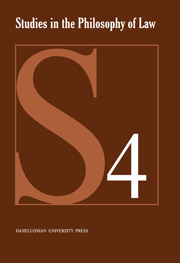Book contents
- Frontmatter
- Contents
- Preface
- Six Causes of the Dispute over Legal Bioethics
- Bioethics and Legal Philosophy
- The Outline of the Subject of Biojurisprudence
- Law and Biotechnology
- The Ethical Significance of Evolution
- Human Nature after Darwin
- The Notion of the Person in Bioethical Debates
- The Roots of Normativity. From Neuroscience to Legal Theory
- Why No One Should Ever Win the Nobel Prize: Neurolaw, Reward and Punishment
- Is There Anybody Who Really Wants to Live Forever? The Significance of Mortality
- The Slippery Slope Arguments Against the Legalization of Physician-Assisted Suicide
- Ethical Problems of Hematopoietic Stem Cells Transplantation
- Notes about the Authors
Ethical Problems of Hematopoietic Stem Cells Transplantation
Published online by Cambridge University Press: 05 September 2014
- Frontmatter
- Contents
- Preface
- Six Causes of the Dispute over Legal Bioethics
- Bioethics and Legal Philosophy
- The Outline of the Subject of Biojurisprudence
- Law and Biotechnology
- The Ethical Significance of Evolution
- Human Nature after Darwin
- The Notion of the Person in Bioethical Debates
- The Roots of Normativity. From Neuroscience to Legal Theory
- Why No One Should Ever Win the Nobel Prize: Neurolaw, Reward and Punishment
- Is There Anybody Who Really Wants to Live Forever? The Significance of Mortality
- The Slippery Slope Arguments Against the Legalization of Physician-Assisted Suicide
- Ethical Problems of Hematopoietic Stem Cells Transplantation
- Notes about the Authors
Summary
What is hematopoietic stem cell transplantation?
The aim of our article is to present the various ethical dilemmas to which hematopoietic stem cells transplantation (HSCT) gives rise. HSCT, i.e. the transplantation of hematopoietic stem cells derived either from bone marrow (in which case called ‘bone marrow transplantation’) or from peripheral blood, is one of the methods of treating such hematologic malignancies as, e.g. acute and chronic leukemias, aplastic anemia, lymphoma, or hemoglobinopathies. HSCT came into common use – both with regard to adults and children – in the early 1990's. There are two types of HSCT – autologous and allogeneic. In the case of autologous HSCT (applied mainly in treating malignant lymphomas and multiple myleoma) a donor of hematopoietic stem cells is the patient himself/herself after a previous chemotherapy eliminated neoplastic cells from his/her bone marrow. This procedure is preceded by high-dose chemotherapy and is aimed to cause complete hematologic and immunologic reconstitution. In the case of allogeneic HSCT, a donor of hematopoietic stem cells is some other person – not the patient himself/herself. The donor may be either a close relative of the patient (e.g. his/her sibling or his/her parents) – in this case allogeneic HSCT is called ‘haploindentical,’ or a matched-volunteer unrelated donor (MUD) found in the Register of Hematopoietic Stem Cells Donors (after he/she has expressed his/her willingness and consent to donate his/her hematopoietic stem cells).
- Type
- Chapter
- Information
- Studies in the Philosophy of LawLegal Philosophy and the Challenger of Biosciences, pp. 165 - 172Publisher: Jagiellonian University PressPrint publication year: 2010



